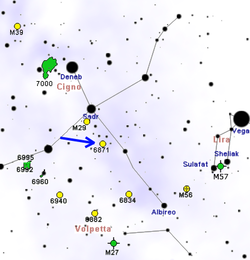| NGC 6871 | |
|---|---|
 NGC 6871, taken from Stellarium | |
| Observation data (J2000 epoch) | |
| Right ascension | 20h 05m 59s [1] |
| Declination | +35° 46.6′ [1] |
| Distance | 5133 ly (1574 pc [2] ) |
| Apparent magnitude (V) | 5.2 [3] |
| Physical characteristics | |
| Estimated age | 9.1 million years |
| Presence of eclipsing binary stars [4] | |
| Other designations | GC 4548, h 2067, Struve 2630 [3] |
| Associations | |
| Constellation | Cygnus |
NGC 6871 is a small, young open cluster in the constellation of Cygnus. The cluster has fewer than 50 members, most of which are blue and white stars. It is located 5135 light-years from Earth.

NGC 6871 was born in the same giant molecular cloud with at least six other open clusters. The other open clusters are not gravitationally associated with NGC 6871. NGC 6871 itself also seems to be disintegrating. [5]
| Star name | Effective temperature | Absolute magnitude | Bolometric magnitude | Mass (M☉) | Spectral type | Ref. |
|---|---|---|---|---|---|---|
| HD 190864 | 39900 | -5.5 | -9.3 | 45 | O7III | [6] |
| HD 226868 | 33000 | -6.4 | -9.6 | 40 | O9.7I | [6] |
| HD 227018 | 41000 | -4.9 | -8.8 | 38 | O7V | [6] |
| HD 191201 | 31600 | -5.8 | -8.9 | 35 | B0V | [6] |
| WR 133 A | 70800 | -3.4 | -8.81 | 9.3 | WN5o | [6] [7] |
| ADS 13374 B (Companion to WR 133 A, also WR 133 B) | 30000 | -5.4 | -8.49 | 22.6 | O9.5I | [6] [7] |
| HD 227634 | 29500 | -5.3 | -8.2 | 25 | B0.2III | [6] |
| HD 190919 | 26300 | -5.8 | -8.3 | 25 | B1Ib | [6] |
| BD+35 3955 | 26300 | -5.7 | -8.3 | 24 | B1Ib | [6] |